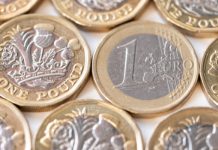The euro continued to fall against the dollar in early trade on Thursday, before rebounding higher. The euro US dollar exchange rate bounced off a low of US$1.0923. This is the lowest level that the euro has traded at versus the dollar for 2 years. The euro is now in positive territory.
The euro extended losses versus the dollar in early trade, despite data showing that German consumer confidence was set to improve in October. The GFK consumer confidence index unexpectedly increased to 9.9, up from 9.7 the previous month and ahead of the 9.6 that analysts had forecast. This is the first time that the index has increased this year, although sentiment remains sour against the historical average.
The euro was also under pressure after Sabine Lautenshläger, a member of the European Central Bank announced that she will step down from her position at the end of October. Lautenshläger is a known hawk and was vocal against central bank’s most recent round of stimulus. Her departure from the ECB could change the balance within the central bank allowing the ECB collectively to adopt a more dovish stance.
Investors will now look towards a speech by ECB President Mario Draghi in Frankfurt. Should Draghi sound negative about the outlook for inflation and economic growth in the bloc the euro could slip lower as investors assume more loosening of monetary policy is on the way.
| Why do interest rate cuts drag on a currency’s value? |
| Interest rates are key to understanding exchange rate movements. Those who have large sums of money to invest want the highest return on their investments. Lower interest rate environments tend to offer lower yields. So, if the interest rate or at least the interest rate expectation of a country is relatively lower compared to another, then foreign investors look to pull their capital out and invest elsewhere. Large corporations and investors sell out of local currency to invest elsewhere. More local currency is available as the demand of that currency declines, dragging the value lower. |
US Economy Grew 2% In Q2
The dollar put in a strong performance in early trade on Thursday, extending gains from the previous session. The dollar advanced even though risk appetite picked up on renewed hopes of a breakthrough in US — China trade dispute. Usually when risk appetite increases demand for the safe haven dollar declines.
The dollar has pared some gains in reaction to news that the US economy grew 2% in the second quarter. This was the final revision for the quarter and was inline with analysts estimates. Whilst it is not a bad reading, it is down considerably from economic growth of 3.1% in the first quarter of the year. The GDP release also highlighted much weaker business investment in the second quarter than previously estimated, which unnerved investors.
Whilst there are some second tier data points due to be released later today, such as pending home sales, investors will look ahead to US durable goods orders and PCE inflation figures tomorrow.
| What do these figures mean? |
| When measuring the value of a pair of currencies, one set equals 1 unit and the other shows the current equivalent. As the market moves, the amount will vary from minute to minute.
For example, it could be written: 1 EUR = 1.12829 USD Here, €1 is equivalent to approximately $1.13. This specifically measures the euro’s worth against the dollar. If the U.S. dollar amount increases in this pairing, it’s positive for the euro. Or, if you were looking at it the other way around: 1 USD = 0.88789 EUR In this example, $1 is equivalent to approximately €0.89. This measures the U.S. dollar’s worth versus the euro. If the euro number gets larger, it’s good news for the dollar. |
This publication is provided as general information only and is not intended as an exhaustive treatment of its subject. TransferWise Inc. and its affiliates (“we” or “us”) expressly disclaim any contractual or fiduciary relationship with you on the basis of the content of this publication, and you may not rely thereon for any purpose. You should consult with qualified professionals or specialists before taking, or refraining from, any action on the basis of the content in this publication. The information in this publication does not constitute legal, tax, investment or other professional advice from us. We make no representations, warranties or guarantees, whether express or implied, that the content in the publication is accurate, complete or up to date, and DISCLAIM ANY IMPLIED WARRANTIES OF MERCHANTABILITY OR FITNESS FOR A PARTICULAR PURPOSE.





